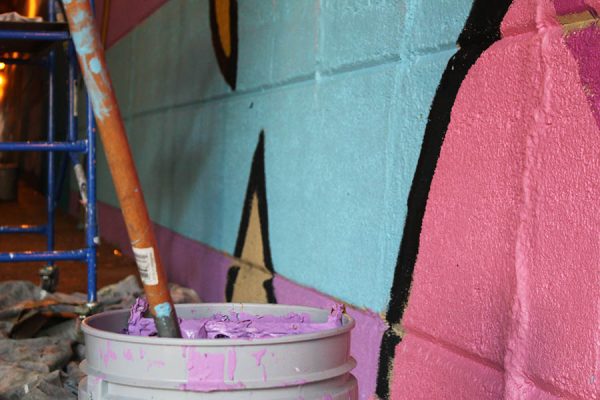Get the Lead Out: The Gov’t’s Known About Lead Contamination in the Riverwards Since Bell Bottoms Were Cool
Here’s a weird one for you: What do hundreds of children’s teeth, the dirt under the Aramingo Avenue Applebee’s and former Rhode Island Governor Don Carcieri have in common? Give up? The answer is lead.
Before 1997, the shopping center on Aramingo Avenue between Cumberland Street and Huntington Street was a large chemical plant that produced things like lead paint, paint coatings, powders, sheeting, pipes, cabling and a host of other lead-related chemicals and products. Site ownership tossed and turned since the factory first opened in the mid-19th century.
Residents, press, public health researchers and government officials have for decades been concerned about the emissions this facility produced and related adverse health effects on people living near it.
Anzon, Inc., a subsidiary of British ceramics engineering firm Cookson, PLC, owned and operated the facility throughout the late 80s until 1997. Environmental Protection Agency (EPA) records show that the plant released 228,335 lbs. of lead waste between 1991 and 1995.
The City of Philadelphia began to subsidize blood lead tests for residents near the Anzon site after arsonists burned a factory-owned trailer in 1988, according to a press release St. Christopher’s Hospital issued that year.
A 1991 waste management accident at the site spat approximately 100 pounds of green lead oxide smoke into the air surrounding it, leading to the evacuation of 75 people.
By then residents had already filed several lawsuits against the firm alleging regulatory violations and negligence. Rather than bring the facility into compliance with emissions regulations, Cookson sold the former Anzon site in 1997 along with several other similar US facilities for $90 million. Developers came in, tore the factory down and cemented over it. The site is now an Applebee’s and a Wawa.
In 1995, a jury ordered that Anzon pay two plaintiffs about $18,000 in cleanup costs. The firm unsuccessfully appealed that decision. Litigation by residents against Anzon over lead contamination-related issues at the site outlived the structure itself.
Former Cookson executive Don Carcieri later accepted some blame with regard to lead emissions at the Philadelphia plant. The year the former Anzon site closed, he also accepted a $1.6 million paycheck from Cookson and a $613,000 “mid-term incentive” and left with $438,000 in stock options, according to the firm’s 1997 shareholders’ report. Carcieri was elected Governor of Rhode Island in 2003 and served in that position until 2011.
Pennsylvania Department of State records show that Anzon and another firm called Associated Lead, which also held interest in the factory, dissolved as corporate entities in 1997 and became AI Divestitures.
So, the Anzon executives cashed out and disappeared. The lead contamination hasn’t.
Occupational health researchers have documented the connection between high incidences of lead exposure-related illness and smelting factories in this area since at least the early 20th century. In 1907, David L. Edsall wrote that Episcopal Hospital at Front and Lehigh treated 23 cases of chronically lead-poisoned workers from one local factory in a two-year span. At least 11 lead smelters have operated in East Kensington at some point since the 19th century, according to research by William P. Eckel published 2001 in the American Journal of Public Health.
In the 1970s, clinical researcher and pediatrician Herbert Needleman collected several hundred baby teeth from school-aged kids in Philadelphia’s Logan and Kensington neighborhoods to test them for lead content. He found high concentrations in teeth from about 100 kids living near St. Anne’s School near Lehigh and Aramingo Avenue.
Needleman later discussed his research in a 2003 Public Health Reports interview. He visited St. Anne’s and found the school was nearby the former Anzon site. A company called National Lead ran the operation at that time. The factory, Needleman recalled, “spanned both sides of a huge street. The children in St. Anne’s were getting as much lead from industrial emissions as the inner-city kids who got lead from paint. Of course it caused a little hullabaloo, but the city didn’t do a thing about it.”
Incidentally, St. Anne’s has since closed and reopened as a school for children with special needs, many of whom experience autism: a condition some researchers associate with exposure to endocrine disrupting chemicals such as lead.
In 2014, the Center for Disease Control (CDC) sampled blood from 126 kids living near the site. Results showed that 11 percent had frighteningly high blood lead levels.
More recently, geologists analyzed soil near the former Anzon site and published their findings in Environmental Justice earlier this year. They found soil lead concentrations at that site about 20 times higher than samples from Philadelphia’s Nedro and Overbrook neighborhoods.
The EPA has thus far refused to remediate the former Anzon site. Regardless of what research accumulates, they require direct evidence that the factory is the main cause of the lead contamination in residents that live near it, not house paint or gasoline exhaust residue. Anzon’s attorneys argued similarly in court throughout the 1990s against orders that they pay for site remediation and medical care for nearby residents sickened by lead exposure.
But rather than address what some may consider an accountability vacuum, government now instead seeks to “reduce or eliminate dangerous lead sources in children’s environments before they are exposed,” according to a recent CDC report on the former Anzon site.
The federal directive has shifted away from investigating the sources of lead contamination and gauging the extent of the damage it causes. Involved government agencies now instead concentrate on educating people about the health problems lead exposure causes and how to avoid it.
Awareness, however, doesn’t appear to make lead less toxic. Public Health Reports in 2011 surveyed the impact of a city program designed to educate Philadelphia families about lead contamination. “[L]ead education significantly increased knowledge,” researchers found. But “mean BLLs [blood lead levels] around one year of age were not statistically different between the study group and a control group.”
USA Today received conflicting information from the EPA regarding their plan for future action at the former Anzon site. Both CDC and EPA officials said they’d require that The Spirit file a Freedom of Information Act request to review their documentation on lead toxicity in this area. The Philadelphia Public Health Department has not yet responded to a Right-to-Know request for air quality records from the Department’s 3900 Richmond St. monitoring facility between 1980 and 1996.
Prolonged lead exposure can damage the nervous system, blood, kidney, liver and brain, according to Interdisciplinary Toxicology’s 2012 literature review. It can also decrease IQ, stunt growth and cause reproductive health and developmental problems, tremors, hypertension, anemia, motor skill damage, memory loss and hyperactivity. Much research shows that exposure harms children most significantly.








